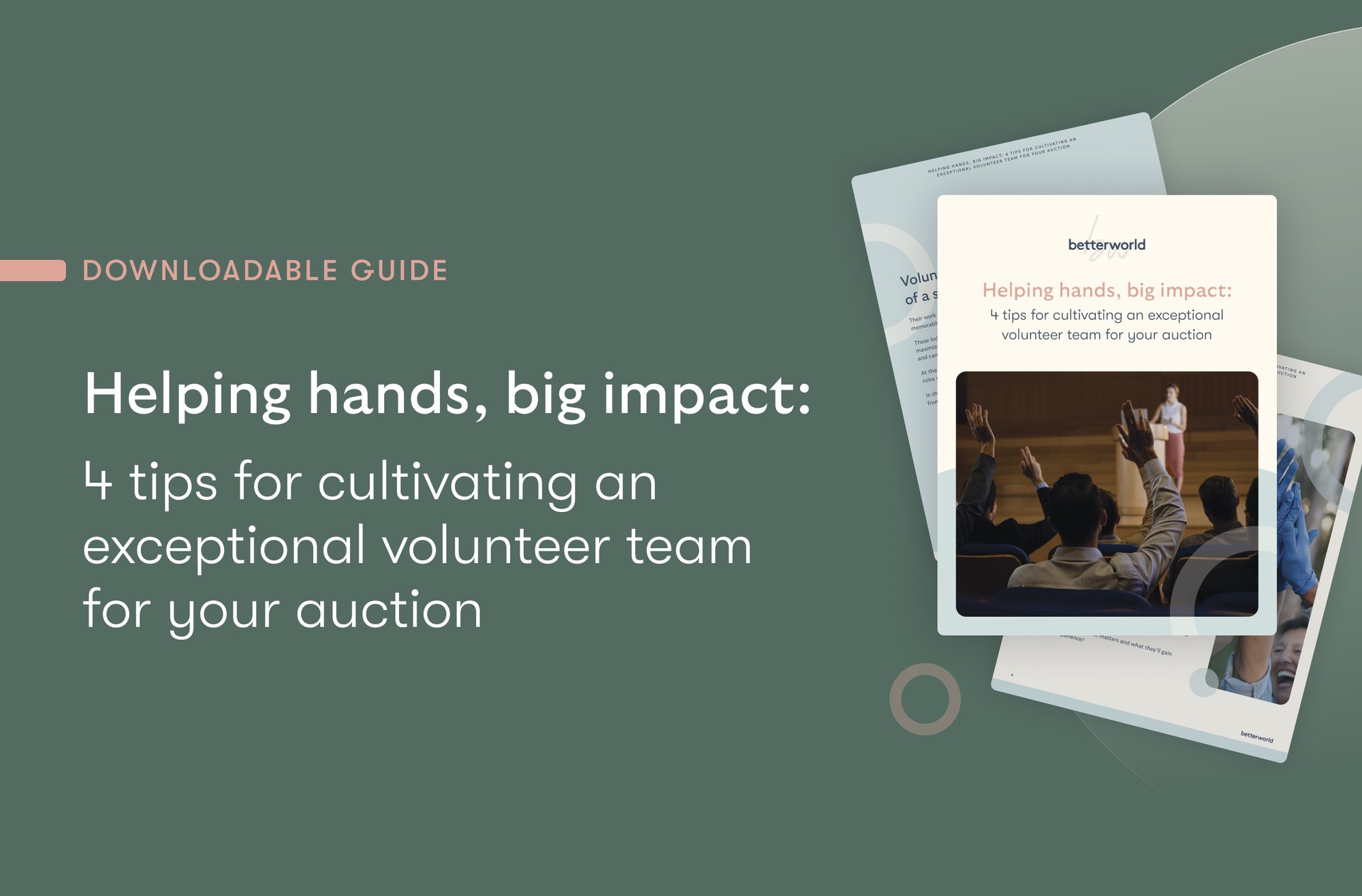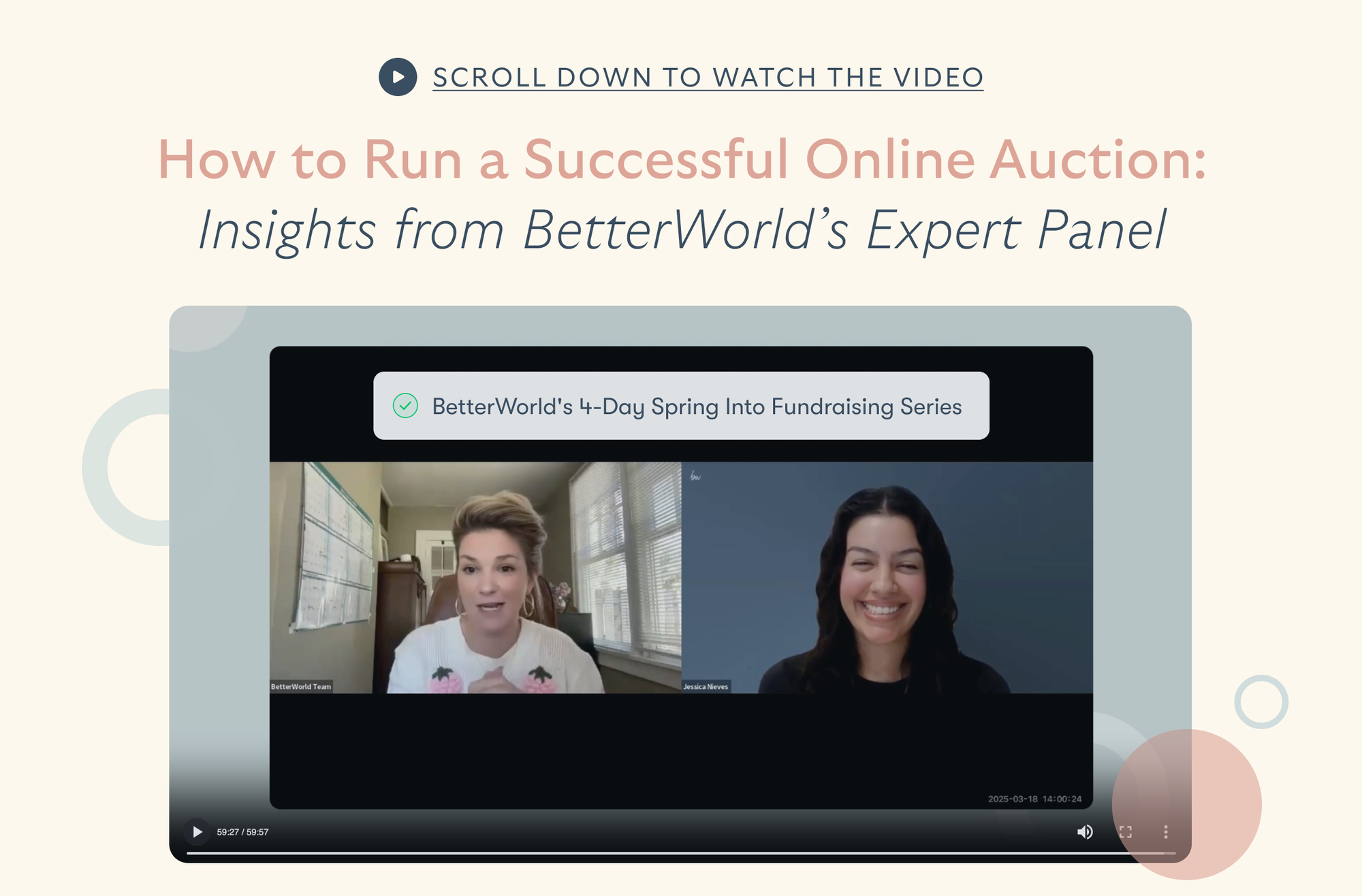Seamless online and in-person actions that raise more
Incredibly easy to set up, backed by an amazing support team
Thoughtful automations that save you dozens of hours
Thousands of dollars of “Instant Items” you can use in your auction at no cost
What Should Nonprofits Do With Unsold Silent Auction Items?
By Colin Hunter

In a perfect world, every item at your nonprofit's silent auction would spark a bidding war and find a new home by the end of the night. However, the reality is that not all items will sell, and it’s quite common to end the night with some pieces still on the table.
If you find yourself in this situation, you’re not alone. Many nonprofits encounter this very issue, but the key is not to see it as a setback. Instead, it's a chance to think creatively and strategically about what to do next.
Having a plan in place for unsold silent auction items is important, and it can turn what seems like a disappointment into an opportunity for further engagement and support. Let’s discuss how you can do it!
1. Re-Auction The Items Online
Hosting a follow-up online auction can be a great strategy if items don't sell during the original event. It gives you a second chance to sell while reaching a potentially larger audience.
BetterWorld is the perfect place to host your follow-up online auction. It is FREE and easy to use, which makes it an excellent choice for nonprofits looking to host an auction without additional costs.
With over 85,000 amazing nonprofits already using it, BetterWorld offers tools and features that can help make your auction a success.
Promote the online auction through your nonprofit's email lists, social media channels, and website. Inform your supporters about the chance to bid on fantastic items and help a good cause from the comfort of their homes. Make sure to mention that all proceeds will support your nonprofit's initiatives.
Set a timeline for your auction that allows ample time for engagement but maintains urgency. Typically, one week is a balanced duration, giving enough time for the word to spread while keeping the momentum going.
Tips on How to Sell the Unsold Item at Re-Auction
- Consider lowering the starting bids if items didn't initially sell. Attractive starting prices can spark more interest.
- Use compelling descriptions and high-quality images. Detailing the uniqueness or backstory of an item can increase its appeal.
- Things like free shipping or an additional small gift can make bids more enticing. For example, if you’re auctioning a book, including a bookmark can be a charming touch.
- Regular updates about the auction can keep your audience involved. Remind them about the closing date and highlight items with fewer bids to drum up interest.
- If possible, find out why attendees didn’t bid on certain items during the first auction. This insight can help you adjust your strategy for the re-auction.
2. Convert to Direct Sale Items
Turning unsold auction items into direct sale items offers an easy approach to recovering some of their value. You can simplify the process by setting a fixed, reasonable price that allows people to purchase items directly without the need for bidding.
To convert auction items to direct sales, begin by evaluating each item to determine a fair price.
Remember, the price should be appealing to potential buyers and reflect the item's value, possibly lower than the original auction starting bid, to encourage immediate purchase.
Set up a display area for these items at your organization’s events, office, or other suitable location. Clearly label each item with its price and any relevant details about its significance or backstory to increase its appeal.
You can also create an online listing for these items on your nonprofit's website or social media platforms to reach a wider audience.
3. Use Unsold Items for Future Fundraising
Using unsold items for future fundraising not only saves resources but also provides new opportunities to engage with your community. Here’s how you can effectively store and repurpose these items for upcoming events.
How to Store and Repurpose Items for Future Events
First, ensure proper storage of these items to maintain their condition. Find a clean, dry area to store items such as artwork, gift baskets, and electronics. For larger items, consider using a dedicated storage facility, especially if space is a concern at your primary location.
Secondly, think about how these items can be reintroduced. Items that were not suitable for one event might be perfect for another.
Ideas for Integrating Items into Different Types of Fundraisers
- Raffles and Giveaways: Some items might work better as raffle prizes or giveaways at events. Offering them in this new format can sometimes generate more interest than an auction.
- Bundling Items: Combine related items into attractive packages that can be auctioned or sold. For example, bundle a set of books with a cozy blanket for a winter event or group a set of spa items for a wellness-themed fundraiser.
- Online Campaigns: Feature these items in online fundraising campaigns. Highlight each item’s story and significance to your cause to add an emotional appeal and encourage donations.
- Reward for Donations: Use unsold auction items as rewards for reaching certain donation thresholds during fundraising drives.
- Silent Auctions at Corporate Partnerships: If you have relationships with businesses, consider asking them to feature these items in a silent auction at their workplace.
4. Donate to Another Nonprofit
Donating unsold items to another nonprofit can be a mutually beneficial strategy. Here’s how to go about this effectively.
Identifying Suitable Nonprofits for Donation
Start by identifying other nonprofits whose missions match the nature of the items you have.
For example, books and educational materials might be highly appreciated by organizations focused on literacy or education. Similarly, items like clothing or household goods could be a great fit for shelters or community aid programs.
Reach out to these organizations to see if they could use the items you have. With this method, you not only ensure that the items go to a good cause but also help build a network of support among local nonprofits.
Coordinating the Donation
Once you find a nonprofit willing to accept the items, coordinate the details of the donation. Discuss logistics such as transportation and timing.
Ensure that the receiving organization is prepared to handle the items, especially if they are large or require special care.
Documenting and Acknowledging the Donation
Proper documentation of the donation is important for both your records and for the receiving organization. It can also be useful for tax purposes. Provide a detailed list of the items donated, along with their estimated value.
Finally, publicly acknowledge the donation if possible. Highlighting such donations can promote goodwill and encourage others in the community to support nonprofit causes.
Want to raise more from your auction? Try BetterWorld’s Auction Tool for FREE!
5. Return to Donors
If items remain unsold even after exploring other options, it may be appropriate to return them to the donors.
Before deciding to return an item, it’s important to discuss this option with the donor. Explain the efforts made to use or sell the item and why it might be best to return it.
Some donors may appreciate the return, while others might encourage you to keep it for future use or donate it elsewhere.
Handling the Return Professionally
If a donor prefers to have an item returned, handle the process professionally:
- Schedule a convenient time for the return.
- Ensure the item is in the same condition as when received.
- Include a thank note expressing gratitude for the donor’s understanding and continued support.
Maintaining Positive Relationships
Returning an item offers an opportunity to strengthen relationships with donors. It shows that you respect their contributions and are mindful of their intentions.
Keep these donors updated on your organization’s activities and future needs, as they are likely to contribute again.
6. Creative Uses Within the Organization
Utilizing unsold items within your nonprofit can improve your workspace, benefit your staff, and enrich your organization's culture. Here’s how you can creatively incorporate these items.
Examples of How to Use Unsold Items Within the Nonprofit Itself
- Art pieces, decorative items, and furniture that didn’t sell can be used to enhance the appearance of your office or facilities.
- Consider using certain items as rewards or incentives for staff performance and achievements.
- Books, software, and other educational materials can be valuable resources for staff training sessions or to expand your organization’s library.
- Items like tableware, decorations, or even themed merchandise can be reused for future fundraising events or gatherings.
7. Legal Consideration
Here's an overview of the key legal issues and compliance requirements.
Overview of Legal Issues Related to Unsold Auction Items
- Ownership and Use: Verify that your organization retains the right to use, re-auction, or repurpose unsold items. Make sure you are aware of the agreements made with donors prior to receiving the items. Always ensure that these agreements are clear and documented.
- Intellectual Property: Be cautious with items that involve intellectual property, such as artwork or branded products. Ensure that using or selling these items does not infringe on copyrights or trademarks.
- Liability Issues: Consider potential liabilities associated with certain items, especially electronics or machinery, that might require safety checks before use or resale.
- Local Laws: Depending on the state and local laws, specific regulations may dictate how items can be handled, especially if they are of significant value or include regulated substances like alcohol. It's crucial to consult with legal professionals familiar with local laws to ensure that your organization complies with all legal requirements.
Compliance with Tax and Donation Laws
1. Documentation
Keep thorough records of all items, whether sold or unsold, including their estimated value, sale price (if applicable), and details of their disposal or use. Documentation is necessary for tax reporting purposes and donor records.
2. Tax Implications for Donors and Your Organization
Understand the tax implications for both donors and your nonprofit. For example, if items are returned to donors, ensure that the donors are aware of how this affects their charitable contribution deductions.
3. Compliance with Donation Laws
Make sure any redistribution or donation of items to other nonprofits complies with state and federal laws regarding charitable donations.
4. Sales Tax Collection
While nonprofits are often exempt from income tax, this exemption typically does not extend to sales tax. Most states require the collection of sales tax on items sold during auctions, including silent auctions.
5. Fair Market Value and Excess Payments
Assessing the fair market value (FMV) of auction items is also vital. If a sale price exceeds the FMV of an item, the excess amount can be treated as a charitable donation. However, it's important to note that buyers should only pay sales tax on the FMV portion of their purchase.

Join 105,000+ amazing nonprofits, organizations, and fundraisers on BetterWorld

Let our FREE fundraising tools help you raise more funds with less effort








